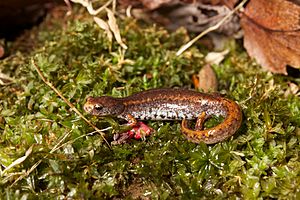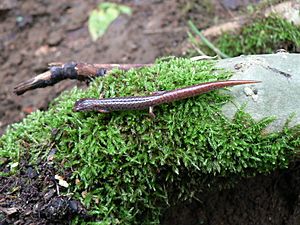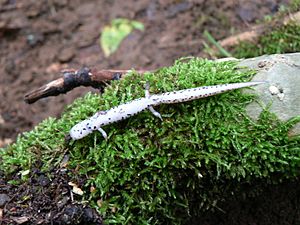Four-toed salamander facts for kids
Quick facts for kids Four-toed salamander |
|
|---|---|
 |
|
| Conservation status | |
| Scientific classification |
The four-toed salamander (Hemidactylium scutatum) is a small, lungless salamander that lives in eastern North America. It is the only species in its special group, called Hemidactylium.
Contents
- What Does the Four-Toed Salamander Look Like?
- How Do Four-Toed Salamanders Reproduce?
- How Do Four-Toed Salamanders Defend Themselves?
- Four-Toed Salamander Nesting Habits
- Where Do Four-Toed Salamanders Live?
- What Do Four-Toed Salamanders Eat?
- Who Hunts Four-Toed Salamanders?
- Are Four-Toed Salamanders Endangered?
- Images for kids
- See also
What Does the Four-Toed Salamander Look Like?
You can spot a four-toed salamander by its white belly, which has small black dots. Its back can be orange-brown or red-brown, and its sides are grayish. Their bodies and legs are long. They have a short snout and big eyes.
The tail is usually brighter than the back. You can also see a clear narrow spot where the tail joins the body. Its back legs have four toes, which is how it got its name! This is a good way to identify them, but it can be hard to see in the wild. These salamanders are usually less than 10 cm (3.9 in) long.
Males and females look similar, but their snouts are different. Males have longer, almost square snouts. Females have short, round snouts. Young salamanders have tails that are shorter than their bodies.
It's easy to confuse the four-toed salamander with the redback salamander (Plethodon cinereus). But the four-toed salamander's belly looks more like "salt and pepper." Also, the redback salamander does not have a narrow spot at its tail, and its back legs have five toes.
How Do Four-Toed Salamanders Reproduce?
Four-toed salamanders mate on land during the autumn. In early spring, the females build nests on land, often near small ponds. After about 4 to 6 weeks, the baby salamanders (larvae) hatch. They then move into the nearby pond.
Compared to other salamanders in the same family, four-toed salamander larvae spend a short time in the water. They stay in the water for about 3 to 6 weeks.
How Do Four-Toed Salamanders Defend Themselves?
The four-toed salamander has three main ways to protect itself from animals that want to eat it.
First, it can drop its tail on purpose to distract an enemy. When the tail comes off, it keeps wiggling. This makes the predator focus on the tail, giving the salamander time to escape.
Second, it can play dead. If it feels threatened, the salamander will thrash around quickly, then suddenly stop and stay completely still. It will stay frozen until it feels safe again.
Third, it can curl up and put its tail on its back. This offers its tail to the predator, hoping the predator will grab the tail instead of the salamander's body.
Four-Toed Salamander Nesting Habits
Female four-toed salamanders have different ways of nesting. They can nest alone or in groups.
When a female nests alone, she lays and takes care of only her own eggs. In communal or joint nesting, one female takes care of the eggs from two or more females, sometimes up to 14! In this group method, some females lay their eggs and then leave the nest. Other females might lay their eggs and stay to care for their own eggs, as well as the eggs of the females who left.
About one-third of all nests in a group are joint nests. Also, between 50% and 70% of females lay their eggs in joint nests each year.
Where Do Four-Toed Salamanders Live?
These salamanders love to live in sphagnum bogs, which are wet, mossy areas. They also like grassy spots around beaver ponds and forests with lots of moss.
Four-toed salamanders use the sphagnum bogs for laying eggs. But they spend their summers in the forest. In winter, they hide on land in old burrows or holes made by rotting roots, staying below the freezing ground. They often spend winter in groups, sometimes even with other amphibians like the red-backed salamander.
In Canada, you can find them in southern Ontario and Quebec, and in Nova Scotia. A single group was also found in New Brunswick in 1983. In the United States, they live from Maine to Minnesota and as far south as Alabama. They have also been found in eastern Kentucky.
We don't know exactly how far these salamanders travel. People used to think that their breeding, summer, and winter homes had to be within 100 meters of each other. But new observations suggest they might travel farther than that.
What Do Four-Toed Salamanders Eat?
Four-toed salamanders mainly eat small invertebrates. These include spiders, worms, ticks, springtails, ground beetles, and other insects. Young salamander larvae enjoy eating small aquatic crustaceans.
Who Hunts Four-Toed Salamanders?
Young salamander larvae can be eaten by other salamanders (both adults and larvae), fish, and aquatic beetles. Shrews, snakes, and some ground beetles hunt adult four-toed salamanders. When it feels in danger, the four-toed salamander will drop its tail, which keeps wiggling, to distract predators.
Are Four-Toed Salamanders Endangered?
Even though the four-toed salamander is rare, or at least hard to find in Canada, the Committee on the Status of Endangered Wildlife in Canada (COSEWIC) does not consider it to be at risk. The International Union for Conversation of Nature (IUCN) also lists it as a species of "least concern." This is because it lives in many places and is thought to have a large population.
However, it is at risk in some Canadian provinces, like Quebec. In Quebec, it is considered "Rare" (S3), meaning there are usually between 20 and 100 known groups in the province. In the United States, its status varies. It is "Threatened" in Illinois, "Endangered" in Minnesota, and a "Special Concern" in Wisconsin, Ohio, and Missouri.
Images for kids
See also
 In Spanish: Salamandra de cuatro dedos para niños
In Spanish: Salamandra de cuatro dedos para niños





